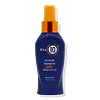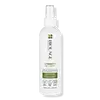What's inside
What's inside
 Key Ingredients
Key Ingredients

No key ingredients
 Benefits
Benefits

 Concerns
Concerns

 Ingredients Side-by-side
Ingredients Side-by-side

Water
Skin ConditioningPropylene Glycol
HumectantCetearyl Alcohol
EmollientCyclopentasiloxane
EmollientBehentrimonium Chloride
PreservativeQuaternium-80
Phenoxyethanol
PreservativeParfum
MaskingMethylparaben
PreservativePanthenol
Skin ConditioningPropylparaben
PreservativeEthylparaben
PreservativeAloe Barbadensis Leaf Juice
Skin ConditioningButylene Glycol
HumectantSodium Hydroxide
BufferingHydrolyzed Keratin
HumectantKeratin Amino Acids
Skin ConditioningHelianthus Annuus Seed Extract
Skin ConditioningSilk Amino Acids
HumectantCamellia Sinensis Leaf Extract
AntimicrobialBenzyl Benzoate
AntimicrobialBenzyl Salicylate
PerfumingHydroxycitronellal
PerfumingLinalool
PerfumingWater, Propylene Glycol, Cetearyl Alcohol, Cyclopentasiloxane, Behentrimonium Chloride, Quaternium-80, Phenoxyethanol, Parfum, Methylparaben, Panthenol, Propylparaben, Ethylparaben, Aloe Barbadensis Leaf Juice, Butylene Glycol, Sodium Hydroxide, Hydrolyzed Keratin, Keratin Amino Acids, Helianthus Annuus Seed Extract, Silk Amino Acids, Camellia Sinensis Leaf Extract, Benzyl Benzoate, Benzyl Salicylate, Hydroxycitronellal, Linalool
Water
Skin ConditioningCetearyl Alcohol
EmollientDimethicone
EmollientBehentrimonium Chloride
PreservativeQuaternium-80
Phenoxyethanol
PreservativePropylene Glycol
HumectantIsopropyl Alcohol
SolventParfum
MaskingSqualane
EmollientButyrospermum Parkii Butter
Skin ConditioningLimonene
PerfumingChlorhexidine Dihydrochloride
AntimicrobialCitric Acid
BufferingHexyl Cinnamal
PerfumingCoumarin
PerfumingBenzyl Alcohol
PerfumingLinalool
PerfumingAmyl Cinnamal
PerfumingGeraniol
PerfumingIsoeugenol
PerfumingAlpha-Isomethyl Ionone
PerfumingHydroxycitronellal
PerfumingBenzyl Benzoate
AntimicrobialCinnamyl Alcohol
PerfumingWater, Cetearyl Alcohol, Dimethicone, Behentrimonium Chloride, Quaternium-80, Phenoxyethanol, Propylene Glycol, Isopropyl Alcohol, Parfum, Squalane, Butyrospermum Parkii Butter, Limonene, Chlorhexidine Dihydrochloride, Citric Acid, Hexyl Cinnamal, Coumarin, Benzyl Alcohol, Linalool, Amyl Cinnamal, Geraniol, Isoeugenol, Alpha-Isomethyl Ionone, Hydroxycitronellal, Benzyl Benzoate, Cinnamyl Alcohol
 Reviews
Reviews

Ingredients Explained
These ingredients are found in both products.
Ingredients higher up in an ingredient list are typically present in a larger amount.
This ingredient is a preservative and often used for it's anti-static properties. You'll most likely see this ingredient in hair conditioners.
It does not cause irritation or sensitization in leave-on products at 1-5%.
Benzyl Benzoate is usually created from the condensation of benzoic acid and benzyl alcohol. It is used as a preservative, solvent, and has a floral/balsamic scent in large amounts.
As a preservative, Benzyl Benzoate works against bacteria and fungus. It is often used to treat scabies and lice in medicine.
Solvents are used to keep ingredients together in a product. They can help dissolve ingredients to stable bases or help evenly distribute ingredients throughout the product.
Due to its fragrance, Benzyl Benzoate can be sensitizing and may cause contact dermatitis. It is a known EU allergen. We recommend speaking with a professional if you have any concerns.
Benzyl Benzoate can be naturally found in cranberries and peaches.
Learn more about Benzyl BenzoateCetearyl alcohol is a mixture of two fatty alcohols: cetyl alcohol and stearyl alcohol. It is mainly used as an emulsifier. Emulsifiers help prevent the separation of oils and products. Due to its composition, it can also be used to thicken a product or help create foam.
Cetearyl alcohol is an emollient. Emollients help soothe and hydrate the skin by trapping moisture.
Studies show Cetearyl alcohol is non-toxic and non-irritating. The FDA allows products labeled "alcohol-free" to have fatty alcohols.
This ingredient is usually derived from plant oils such as palm, vegetable, or coconut oils. There is debate on whether this ingredient will cause acne.
Due to the fatty acid base, this ingredient may not be Malassezia folliculitis safe.
Learn more about Cetearyl AlcoholHydroxycitronellal is a fragrance created from citronellal. The smell of hydroxycitronellal is often described as "citrus-like" or "melon-like".
Hydroxycitronellal is a known EU allergen and may cause irritation when applied to the skin.
Linalool is a fragrance and helps add scent to products. It's derived from common plants such as cinnamon, mint, citrus, and lavender.
Like Limonene, this ingredient oxidizes when exposed to air. Oxidized linalool can cause allergies and skin sensitivity.
This ingredient has a scent that is floral, spicy tropical, and citrus-like.
Learn more about LinaloolParfum is a catch-all term for an ingredient or more that is used to give a scent to products.
Also called "fragrance", this ingredient can be a blend of hundreds of chemicals or plant oils. This means every product with "fragrance" or "parfum" in the ingredients list is a different mixture.
For instance, Habanolide is a proprietary trade name for a specific aroma chemical. When used as a fragrance ingredient in cosmetics, most aroma chemicals fall under the broad labeling category of “FRAGRANCE” or “PARFUM” according to EU and US regulations.
The term 'parfum' or 'fragrance' is not regulated in many countries. In many cases, it is up to the brand to define this term.
For instance, many brands choose to label themselves as "fragrance-free" because they are not using synthetic fragrances. However, their products may still contain ingredients such as essential oils that are considered a fragrance by INCI standards.
One example is Calendula flower extract. Calendula is an essential oil that still imparts a scent or 'fragrance'.
Depending on the blend, the ingredients in the mixture can cause allergies and sensitivities on the skin. Some ingredients that are known EU allergens include linalool and citronellol.
Parfum can also be used to mask or cover an unpleasant scent.
The bottom line is: not all fragrances/parfum/ingredients are created equally. If you are worried about fragrances, we recommend taking a closer look at an ingredient. And of course, we always recommend speaking with a professional.
Learn more about ParfumPhenoxyethanol is a preservative that has germicide, antimicrobial, and aromatic properties. Studies show that phenoxyethanol can prevent microbial growth. By itself, it has a scent that is similar to that of a rose.
It's often used in formulations along with Caprylyl Glycol to preserve the shelf life of products.
Propylene Glycol is an odorless, colorless liquid. As a humectant, it helps skin retain moisture. It also aids in delivering active ingredients.
Another role of this ingredient is preventing a product from melting or freezing. Propylene glycol also adds antimicrobrial properties to a product, elongating product lifespan.
This ingredient is considered an organic alcohol and commonly added into both cosmetics and foods.
Those with sensitive skin or conditions may develop a rash when using this ingredient.
Learn more about Propylene GlycolWe don't have a description for Quaternium-80 yet.
Water. It's the most common cosmetic ingredient of all. You'll usually see it at the top of ingredient lists, meaning that it makes up the largest part of the product.
So why is it so popular? Water most often acts as a solvent - this means that it helps dissolve other ingredients into the formulation.
You'll also recognize water as that liquid we all need to stay alive. If you see this, drink a glass of water. Stay hydrated!
Learn more about Water